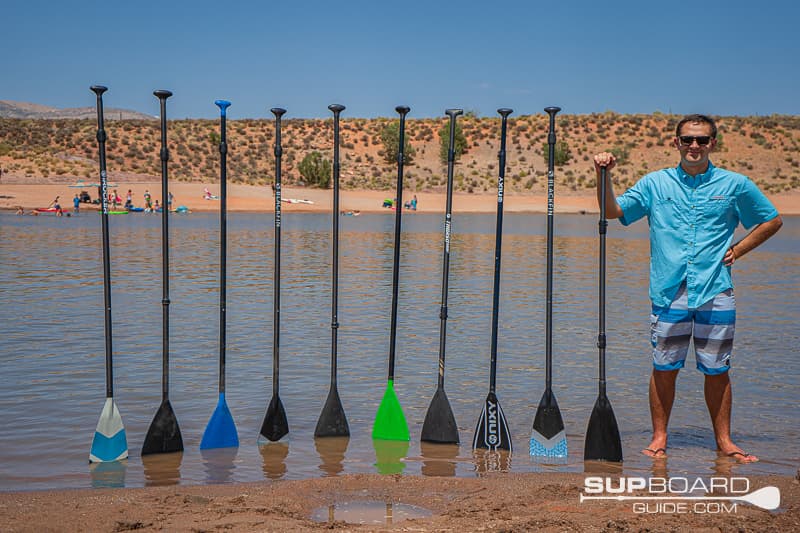
One of the most important things to get into the habit of doing as you learn how to SUP is finding the perfect paddle length. Having a paddle that is too long will cause you to improperly plant your paddle and cause your SUP to drift off course more often. Alternatively, having a paddle that is too short will cause you to stretch and bend more than you need too, making paddling uncomfortable and tiring you out quicker. With the perfect paddle length, you will make paddling easier, more efficient, and overall a more enjoyable experience than you would with an improper length paddle.
But how are you supposed to figure out what the proper paddle length is? With time and experience, it will become practically automatic for you to adjust your paddle until it’s the proper height for you to use. Until you build up that experience though, there are multiple ways that you can determine the proper paddle length.
Before that though, you should be aware of the following:
Important Note: Different activities need different lengths:
One mistake that keeps paddlers from maximizing the ability and performance of their paddleboards is the fact that different SUP activities require a different length. If you are going paddleboard surfing, for example, you will want a shorter paddle, while if you are racing or touring you will want a longer paddle. The exact length it should be will vary on the specific activity and by person, but here are two general guidelines that you can follow as you learn how to SUP:
- For surfing, exploring, and activities that need more maneuverability: Shorten the length of your paddle from your normal length by one to two inches.
- For racing, touring, and activities that need more tracking: Elongate the length of your paddle from your normal length by one to two inches.
As you gain more experience, you will be able to make further adjustments that will help you determine how to bring out the best performance as you engage in a SUP water sport. However, for many beginners, you probably just want to get used to paddling casually and figure out what will be your standard paddle length. So, to help you understand what that is, we recommend using one of the following methods
How to determine your personal paddle length:
Method 1: Use the paddle height chart.

Many current paddles available on the market have a height chart that makes it really easy to determine what the proper length should be for your paddle. If it gives you the height in inches, simply adjust the paddle until it matches your proper height. Alternatively, if it just gives you the inches and centimeters, adjust the paddle length until it is your height plus three to four inches. If that doesn’t feel entirely comfortable, add an inch or two if you have longer arms or take a inch or two away if they are shorter.
Method 2: The Hand’s Up method, or all-around method:
If you have a paddle that doesn’t have a height chart, or perhaps you still find yourself uncomfortable even after adjusting to the suggested length, we suggest the hands up method. Hold your paddle vertically with one hand, or with the blade planted into the ground, and place your other hand on the paddle handle. Next, stretch out the handle until your hand is stretched straight out in the air and lined up with the hand that is gripped to the shaft, at which point you are good to go! This method matches the grip you’ll want to have to maintain a proper paddling technique in the water, and so lets you feel ahead of time how you should be holding your paddle in the water. For casual, all-around performance and for those who are trying to improve their paddling technique, we recommend relying on the Hand’s Up method until you’re totally comfortable with your paddle.
Speaking of which, if you find this article helpful, we recommend heading over to our ‘Improving Your Paddling Technique’ article to find out the next step should follow after sizing your paddle to improve your overall paddling form.
Method 3: Eye Level Method, or touring method:
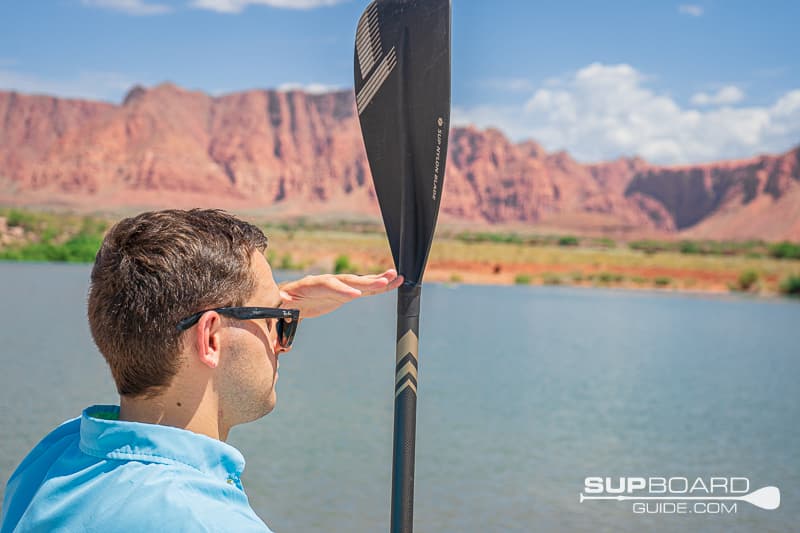
If you find yourself drifting too much as you paddle, or want something that will help you have a more powerful stroke, we suggest using the eye level method. Plant your handle into the ground instead of the paddle blade like the other methods, and start elongating your paddle length. Keep adjusting the paddle until the point where the shaft and paddle blade meet is perfectly level with your eyes. The result of this will be a paddle that is a bit longer than what you would get with the Hand’s Up method, and so is better for touring, racing, and other activities that require improved tracking and speed. This tends to also make the paddle a bit large and unwieldy to use, especially for beginners, so we suggest relying on the Hand’s Up method or proper height chart before resorting to this style of paddle length.
Method 4: The Shaka method, or surfing method:
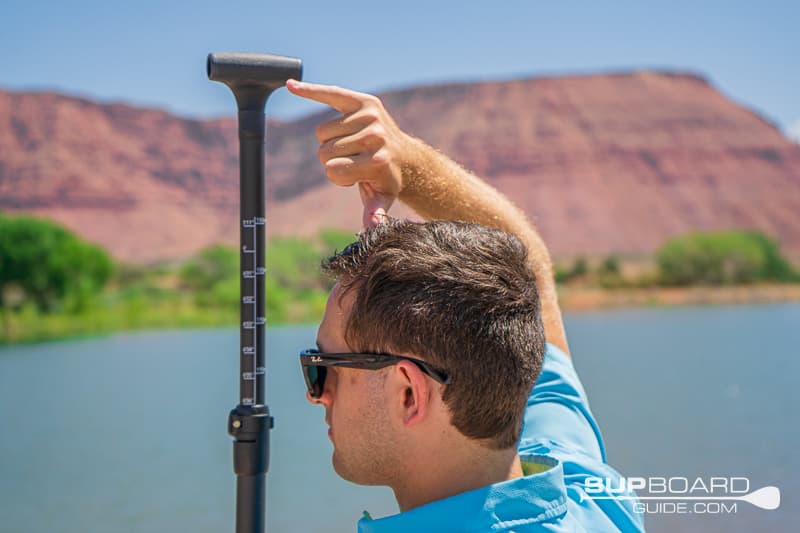
If you are interested in a paddle that is a bit shorter and optimized for surfing and better maneuverability, we would recommend using the Shaka method. A Shaka is when you extend your pinky and thumb sideways, away from your palm, while you close your three center fingers to your palm as if making a fist. Once you’ve made a Shaka, place the tip of your thumb on the top of your head so that your outstretched pinkie is pointing upwards. Now, with your other hand, extend your paddle until the tip of the paddle handle is the same height as the top of your pinke. This will cause your paddle to be just a bit shorter than the Hand’s Up Method, making it better for surfing, those who want better maneuverability, or have shorter arms that aren’t comfortable when using the Hand’s Up method.
These are just a few of the methods that can be used to help you determine your perfect paddle length. While it may be a bit tedious to use these methods as you first start paddling, you’ll appreciate using them and soon find yourself doing them automatically. After just a few tries and a few weeks of paddling, you’ll be making the proper adjustments to your paddle even out on the water without any trouble.
These methods will work with the vast majority of paddles on the market, but we do want to also talk a bit about how specific types of paddles will impact your proper paddle length.
How to determine your personal paddle length:
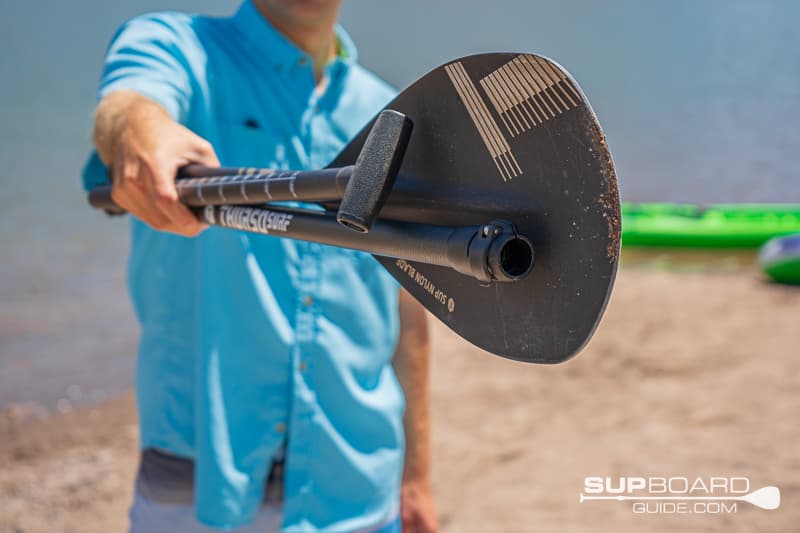
Permanent, one piece paddles: One piece paddles tend to be favored by more experienced and advanced paddlers, and are almost never included with the base kit of a paddleboard. One piece paddles are lighter and provide a more powerful paddle stroke, making you faster on your SUP, but have the drawback that they cannot be adjusted to fit multiple paddler heights. You can change where you grip on the paddle, but the shaft itself traditionally cannot be made longer or shorter. We recommend staying away from one piece paddles until you feel experienced in paddling and know what you want your specific and perfect length to be.
Two/Three/Four Piece Paddles: Multi-piece paddles are what are typically included with many paddleboard kits, though many premium paddles also fall under this category as well. The more pieces that the paddle has, the more you can specialize and adjust the length, with four piece paddles a good choice for paddlers taller than 6’6’’ or shorter than 5’. However, the more pieces a paddle has, the more it will traditionally weigh overall, besides also taking a few more seconds to adjust or put together. Due to how easy it is to pack multi-piece paddles though, along with their overall benefits, we tend to recommend them for most beginner and intermediate paddlers.
Kayak conversion paddles: Kayak paddles are traditionally multi-piece paddles that are pre-built in such a way that you can replace the handle with a second paddle blade for a converted kayak paddle. These paddles are also nifty in that they also have the added benefit of more length customization options than traditional SUP paddles, even if you never use the second kayak blade. These are also some of the most heavy paddles out there though, even when built with carbon-fiber, so stick with a traditional paddle without the kayak option if you want to cut back on weight.
Final Note: Does weight impact how long my paddle should be?
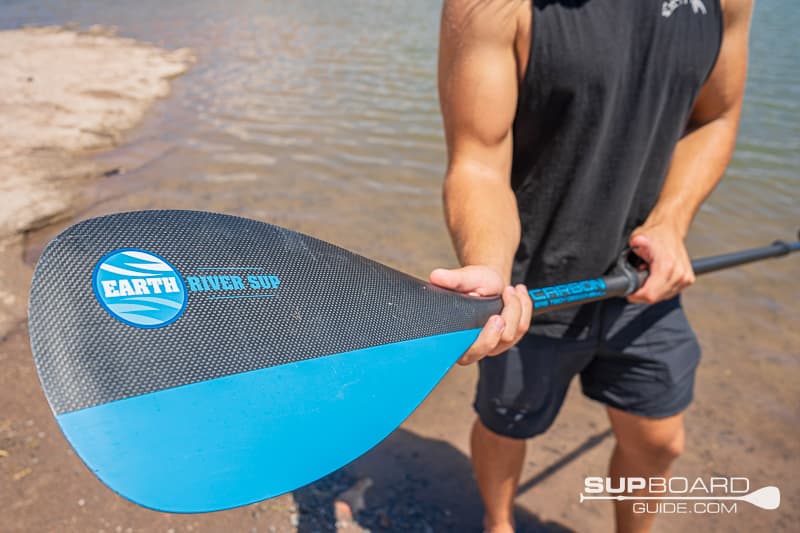
While the majority of paddles will offer similar performance to one another when used correctly, different materials will result in the paddle weighing differently from another. Materials like aluminum and plastic are the heaviest bases for a paddle, but are also packed in with many beginner or entry-level SUPs and are inexpensive to buy. Alternatively, carbon fiber or fiberglass paddles tend to be more expensive and are included only in more premium SUP kits, but they weigh less for it. Finding the balance of a lightweight paddle that you can also afford is an important consideration before choosing a paddle.
So how does weight affect length? When it comes to using a paddle for short bursts, the overall weight won’t impact how long you should make your paddle. If you are paddling for a long period of time though, or are starting to optimize your paddle length for performance, weight is an important factor to consider.
Longer paddles are tricker to hold and use, and tend to tire out paddlers quicker than a more traditional length paddle. Because you are already losing stamina faster, having a heavy paddle will further exacerbate the issue and make it even more difficult to use an elongated paddle for touring or racing. If you want to use an elongated paddle for an extended period of time, we recommend investing in at least a fiberglass shaft and blade or anything that’s lighter than 29 ounces.
Shorter paddles do cause you to bend more, causing a burn in your core quicker, but it isn’t as impacted as much by a heavier paddle. However, while you might not tire out as quickly, we do find that heavier paddles have a tendency to cause paddlers to lean over too much when paddling, affecting tracking. Shorter paddles themselves are already used with the purpose of increasing maneuverability at the expense of tracking, but while you are compounding a performance issue more experienced paddlers don’t tend to make this mistake. If you are a beginner and need a shorter paddle length without sacrificing too much tracking, we would recommend considering at least a fiberglass shaft and nylon blade. Alternatively, any paddle lighter than 32 ounces should be light enough that you won’t find yourself leaning excessively while you paddle with a short length paddle.
Conclusion: The Perfect Length is Up to You:
All of our above tips are ultimately suggestions, as the perfect paddle length is ultimately going to be left up to the individual. Some paddlers will prefer something longer than average, while others may go with something shorter. Ultimately, experience and just taking the time to paddle is what is going to help you figure out your favorite paddling length. So, remember to have fun, and get out there and paddle!
With that in mind, thank you so much for reading! We hope this guide has been helpful and provided you with ways to become more familiar with SUP paddles. If you have any questions or would like additional information about a particular paddle brand or SUP, be sure to leave us a comment below or send us an email! We are happy to help anyway we can so that you can not only become a better paddleboarder, but can enjoy the sport more. We also appreciate feedback, so if you have some of your own tips or other beginner articles you would like to see from us, we would be happy to hear from you.
Just remember the most important tip: make sure to have fun SUPing!
SupBoardGuide
Latest posts by SupBoardGuide (see all)
- Best Paddle Boards for Beginners, 2025 - July 3, 2025
- Hala Radito Whitewater iSUP Review – 2025 - June 27, 2025
- Hala Atcha 96 Whitewater iSUP Review – 2025 - June 16, 2025






You explanation for the Method 2: The Hand’s Up method is confusing. Is my hand on the handle supposed to be straight up or straight out horizontal?
I’m assuming it is up but the instructions say straight out and lined up with the hand that is gripped to the shaft. I don’t even know what that means. 😂
Hi Rob, thanks for pointing that out; we can definitely see how it’s confusing. Yes, your hand holding the handle should be straight up. Basically, if you hold one hand straight up in the air, your paddle handle should come up to your wrist (of course some adjustments can be made depending on what is more comfortable for you).